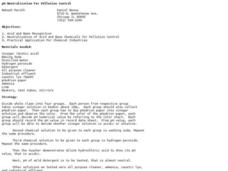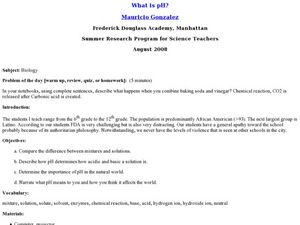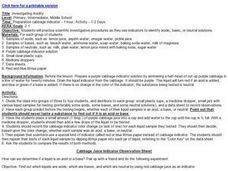Curated OER
Chemical Leavening Agents
Students examine chemical leavening agents in dough and batters.
Curated OER
PH Neutralization For Pollution Control
Students recognize whether a solution is an acid or a base. In this acids and bases lesson plan, students use chemicals and identify if those chemicals are acids or bases. From the conclusion, students will be able to identify if the...
Curated OER
Observing Buffers In Lakes, Ponds And Streams
Pupils observe the effects of limestone on the acidity of water. Some areas of the nation have a lot of limestone in lake bottoms and in soil, which helps neutralize the effects of acid rain. Students see this effect first hand.
Curated OER
Volcanoes
Students explore the formation of volcanoes. In this earth science lesson, students build their own volcanoes in the lab using different materials. They identify the different types of volcanoes.
Curated OER
Soil Buffering
Students observe the pH change of an acid mixture poured over soil in a filter. Since the buffering capability of soils differs, you may want to do this experiment with several different soil types.
Curated OER
Looking At Acid's Effects On Metals
High schoolers perform an experiment that demonstrates acid rain. The chemical effect of acids on metals may take at least five days for the human eye to see, even though the reaction starts as soon as the acid contacts the metal.
Curated OER
What is pH?
Pupils describe pH and the importance of it in the natural world. For this Biology lesson students compare the pH of different mixtures.
Curated OER
Investigating Acidity
Students classify liquids as an acid, base or neutral. They use purple cabbage juice as an indicator to test several liquids in order to group them as acids, bases or neutrals.
Curated OER
Kitchen Chemistry
Fifth graders examine both physical and chemical changes, and how to identify the difference between the two. They observe the changes that occur in butter when it is exposed to heat and cold, heat energy. In their notebooks, they write...
Curated OER
Making A Natural pH Indicator
Students make their own pH indicator from red cabbage. Red cabbage contains a chemical that turns from its natural deep purple color to red in acids and blue in bases. Students boil the cabbage to get the pH indicator.
Curated OER
The pH scale
Students list the common properties of acids and bases. They classify substances as acids or bases, by using pH and litmus tests and are able to explain the pH scale. They participate in a lab activity which reinforce their understanding.
Curated OER
What's the Matter?
First graders identify solids, liquids, and gases. In this matter activity, the teacher guides students through numerous demonstrations as they determine the properties of solids, liquids, and gases and classify things as each. As the...
Curated OER
Solids, Liquids, and Gases
Students explore solids, liquids, and gasses and categorize and describe the three states of matter. In this chemistry lesson plan, students categorize items as solid, liquid, or gas based on the definitions given by the teacher....
Curated OER
Blast Off to Learning
Young scholars explain the laws of volume and pressure, identify what a limiting reagent is and why it is important in a chemical reaction, and distinguish between fossil fuels and renewable energy sources.
Curated OER
Acids & Bases: What's the Solution?
Learners conduct an experiment called "What's the Solution? Acid, Base or Neutral." to determine the differences between these types of substance.
Curated OER
Igneous Rocks/Volcanoes
Learners differentiate between the two types of igneous rock and designate the area the rock comes from.
Curated OER
Scientific Method "Lab Writeup"
Students analyze and experience the scientific method. They discuss the various steps of the method, conduct various experiments, and write a three-paragraph essay regarding their conclusion.
Curated OER
Identifying Acids and Bases
Sixth graders observe the physical and chemical change that can occur in an acid and a base. In this acids and bases lesson plan, 6th graders use cabbage juice to identify, compare, and contrast acids and bases.
Curated OER
Introduction to Neutraliization
Students explore acids and bases and the process of neutralization.T hey practice volume measurements and observe the neutralization of an acid
directly through bubble formation and indirectly through indicator color changes.
Curated OER
Using Your Senses
Students use their senses to make observations. In this senses lesson plan, students investigate unknown substances by using their senses for observations. Students identify the number of the substances used, the color, the odor, the...
Curated OER
Chemical Changes
Second graders investigate chemical changes and reactions and will identify four characteristics that indicate a chemical change. For this chemical change lesson plan, 2nd graders perform experiments that promote chemical changes. They...
Curated OER
Heat Loss and Gain in Physical Changes and Chemical Reactions
Students measure the heat of physical and chemical changes in reactions. In this chemistry lesson students determine at what extent changes emit or absorb heat.
Curated OER
States of Matter
Students study the vocabulary of the states of matter. In this states of matter vocabulary instructional activity, students investigate and study the meaning of the words solid, liquid, and gas. They experience demonstration lessons that...
Curated OER
Safe Subs
Students investigate ways to reduce use of hazardous materials. In this safe substitutes lesson, students review hazardous wastes used in many homes and possible safe substitutes for these harmful chemicals. Students write and decorate...
Other popular searches
- Vinegar and Baking Soda
- Vinegar & Baking Soda
- Baking Soda Vinegar Lab
- 5th Baking Soda Vinegar
- Gas Baking Soda Vinegar
- Baking Soda Vinegar Balloon

























